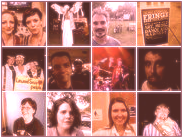Muder We Wrote at Rollins College
Where does one begin? I often find that when writing these theatre reviews, it’s a good idea to gather my thoughts, think about what I want to say and in what order; I don’t have time for that, I’m going back to see the last showing in an hour!
I first learned about this production through a friend who helped to workshop the format for this improvised 90-minute board-game inspired murder mystery… she and several other students, under the direction of David Charles, PhD. - Assistant Professor of Theatre and Dance at Rollins College. The whole play is improvised, so there are bound to be some times during such a long show where the scenes may be stronger or weaker - to counteract that, “Dr. David” and his class developed dozens of devices to help them create a sustainable story throughout the length of the show.
We begin at the stately home of a Mr. Phil Reynolds, a successful lawyer with a deceased rich wife. His business partner Toni and spouse Gene the artist will be guests at tonights party, along with his child Bobby and sibling Toni, servant Pat, and lifelong friend Dr. Chris. An unexpected guest arrives, and, inevitably, there is a murder! Some classic (yet improvised) scenes are played on the stage of the Annie Russell Theatre, which has been masterfully converted to the perfect setting for these 8 unlikely murderers or murderesses to play out their little drama. You’ll laugh, you’ll scratch your head, and above all you’ll have fun.
I’ve got so much more to tell, but no time to tell it… we continue our recap when I return from the last showing of Murder We Wrote tonight!
**** Continued ****
As the play begins, you see a man sitting at a bar, and as he turns to the audience, he gives us the look the look that says “Are you ready for this?”. At all three showings, David’s entrance gave us a laugh. This audience was ready to have fun. The story is set up as an “exploration of the human psyche” where “a seemingly random series of events” may yield “murderous results”, and the setup for the game begins. Three decks of cards are passed out to the audience and shuffled, then used to select a victim, a murder weapon, a location and… the murderer. The recited banter during this section kept us paying attention, instead of looking down at our “ballots” where we would later guess whodunnit. Only the Assistant Director and the killer know all the details of the crime before the final moments of the play when a confession is yanked out of the murder him or herself.
Once the setup is done, we the audience have also suggested a song title, a nervous habit, an annoying catch phrase, and several other ways for the players to use to make us feel as much like the writers of the story as the people on and off stage. Just before, however, is perhaps the most exciting part: the character cards are shuffled, and 7 of the 8 roles are completely randomized by members of the audience. All the parts are non-gender specific, including the married couple, and relationships between siblings and children. Even the order of entrance for the characters is ever-changing, decided by the backstage team of a dozen or more people who are constantly feeding the actors suggestions, props, cues, even their catchphrases, and reconciling any plot holes during intermission. There are countless challenges for the lighting and sound team as well, and opportunities for them to drive the story as much as anyone down at the stage level.
The most rewarding parts of the show come in the second act, where the details of the murder are spoon-fed to us at fixed intervals (or as much as can be with an improvised show). We already know the victim before we take the intermission and make our guesses, and immediately after, the location of the murder is revealed. I don’t know to give credit to one person for this, or the whole team of students, along with Dr. David who playtested and researched this last summer, but there is some expert game design at work here.
Then someone suggests “we should split up and search the house”, and each of the 8 characters takes one of the doors leading to various wings and levels of the house, only to frantically burst out of the door in a ballet of “who am I on stage with, and what do we do now?”, the inner workings of which I know is my job to keep a secret, but congratulations to J. Hannah White, the lighting designer for her brilliant stroke on that one. There’s also a more traditional improv game set up in the coat closet, at the bar, and up on the balcony, where the players pass lines to each other like a hot potato that is always unpredictable and fun. It’s these sort of moments that make us forget we’re watching the story being written in real-time.
Last but not least, all the cast re-assemble in the main hall to try and figure out for themselves who the murderer is. Things at this point can get rather tense, and apparently, a wrestling match broke out during this scene on Friday between actor Seth and Dr. David. The atmosphere teeters on melodramatic as actors are eliminated, concealed weapons are pulled, dead bodies lie on the couch and revealing letters are read… or none of these things happen and they just wing it, it’s really different every night.
What’s that? Sorry you missed it? I feel sorry for your too. This show could run every night down on International Drive if the team were so inclined. I don’t remember how much of Sleuths Dinner Theatre is improvised, maybe I’ll have to go back and do some post-game research. So far, the closest things I’ve seen to this level of story plus improvisation in such a long form are The Adventurer’s Club at Pleasure Island, which I would consider a distant script-heavy cousin of Muder We Wrote (all the endings are decided, most of the jokes and songs are repeated, but the cast is always changing), and SAK Comedy Lab’s The Early Show, which plays every other Friday at Midnight, and is completely improvised with no backstage magic, just the performers left to their own devices.
What makes these other productions around town the same or different from this show? In Murder, we the audience are all following this global discovery as we ourselves and the rest of the actors and around-stage hands and minds try to figure out the story. In regular improv or something more scripted, we either have a better or worse idea of where the ending is. We have an idea of how we think it could happen, and the several dozen people actually driving do as well, but there’s no way to know until the last possible moment when the killer reveals his or her secret and we have a collective pay-off. There’s lots more to say about what’s happening here and how they pulled off the format, but then this would be getting into research paper territory, and I’d need to start giving examples from other historic or contemporary works, and… well, we’re only blogging here!
I’ve never taken a theatre class in my life, and I graduated from UCF 4 years ago (almost to the day), but my biggest takeaway from this was a desire to enroll at Rollins under Dr. David Charles. You can tell everyone involved on this play was having such a great time, and the fact that people were coming back to watch a second, third, or even more showings is a testament to the fun and intrigue of this production, and the charm exuded by David and his cast. Congratulations to Megan Borkes, Ana Eligio, Joseph Bromfield, Chelsea Dygan, Erica Leas, Seth Strutman, Emily Smith, Roberto Pineda, Michael Neil Mastry, Danny Tuegel, Liz Weisstein, and Rob Yoho, along with all the other cast and crew, on an excellent run.








